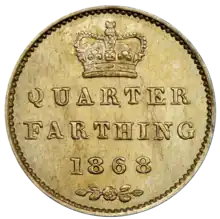United Kingdom | |
| Value | £0.000260416 0.0625d |
|---|---|
| Mass | 1.2 g |
| Diameter | 13.5 mm |
| Edge | Plain |
| Composition | (1839–1853) copper (1868) bronze |
| Years of minting | 1839, 1851–1853, 1868 |
| Obverse | |
 | |
| Design | Queen Victoria |
| Designer | William Wyon |
| Design date | 1839 |
| Reverse | |
 | |
| Design | Crown and rose |
| Design date | 1839 |
The quarter farthing was a British coin worth 1⁄3840 of a pound, 1⁄192 of a shilling, or +1⁄16 of a penny. The Royal Mint issued the coins in copper for exclusive use in British Ceylon in 1839, 1851, 1852, and 1853.[1] The mint also produced bronze proofs in 1868.[2]
The obverse of the coins used William Wyon's obverse die for the Maundy twopence, bearing a left-facing portrait of Queen Victoria and the legend VICTORIA D: G: BRITANNIAR: REGINA F: D:.[1] Wyon designed the reverse to feature a royal crown above the words QUARTER FARTHING and the date. Below the date, the coins featured a heraldic rose with three leaves on either side.[1] The coins were made of copper, weighed 1.2 gramme, and had a diameter of 13.5 millimetres.[1] The mint struck proof quarter farthings in bronze and copper-nickel in 1868, but did not issue any quarter farthings for circulation that year.[2]
While quarter farthings were never legal tender in the United Kingdom,[3] they are fractions of the British farthing, which was currency in Ceylon, and traditionally have been catalogued as British coinage.[4]
References
Sources
- Peck, C. Wilson (1960). English Copper, Tin and Bronze Coins in the British Museum: 1558–1958. London: Trustees of the British Museum.